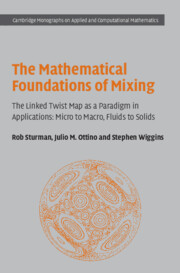 The Mathematical Foundations of Mixing
The Mathematical Foundations of Mixing Book contents
- Frontmatter
- Contents
- Preface
- Acknowledgments
- 1 Mixing: physical issues
- 2 Linked twist maps: definition, construction and the relevance to mixing
- 3 The ergodic hierarchy
- 4 Existence of a horseshoe for the linked twist map
- 5 Hyperbolicity
- 6 The ergodic partition for toral linked twist maps
- 7 Ergodicity and the Bernoulli property for toral linked twist maps
- 8 Linked twist maps on the plane
- 9 Further directions and open problems
- References
- Index
3 - The ergodic hierarchy
Published online by Cambridge University Press: 03 February 2010
- Frontmatter
- Contents
- Preface
- Acknowledgments
- 1 Mixing: physical issues
- 2 Linked twist maps: definition, construction and the relevance to mixing
- 3 The ergodic hierarchy
- 4 Existence of a horseshoe for the linked twist map
- 5 Hyperbolicity
- 6 The ergodic partition for toral linked twist maps
- 7 Ergodicity and the Bernoulli property for toral linked twist maps
- 8 Linked twist maps on the plane
- 9 Further directions and open problems
- References
- Index
Summary
This chapter establishes the mathematical foundations on which to build. The key concepts and results from ergodic theory are given, forming an ordered list of behaviours of increasing complexity, from ergodicity, through mixing, to the Bernoulli property.
Introduction
We will mostly be interested in the simplest mixing problem: the mixing of a fluid with itself. This serves as a foundation for all mixing problems. Practically, we can think of placing a region, or ‘blob’ of dye in the fluid, and asking how long it takes for the dye to become evenly, or uniformly, distributed throughout the entire domain of the flow. We will need the mathematical machinery to make this question precise and quantitative. We will first need a framework to mathematically describe, measure and move regions of fluid. To do so we will introduce simple ideas and definitions from topology, measure theory and dynamical systems. In particular, notions of set theory from topology correspond naturally to properties of an arbitrary region of fluid, such as its boundary, interior and connectedness. Measure theory provides the tools necessary to measure the size of a region in a generalized and consistent way. The basis of the field of dynamical systems is the study of the evolution of some system with time, and these ideas can be applied directly to the application of moving fluid. These are by now all well-established techniques in the study of fluid mechanics (see for example Ottino (1989a)).
To discuss mixing of fluid we will need the area of mathematics known as ergodic theory. This provides a framework in which many physically relevant pieces of the mixing problem can be fruitfully studied.
- Type
- Chapter
- Information
- The Mathematical Foundations of MixingThe Linked Twist Map as a Paradigm in Applications: Micro to Macro, Fluids to Solids, pp. 59 - 104Publisher: Cambridge University PressPrint publication year: 2006
